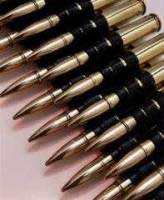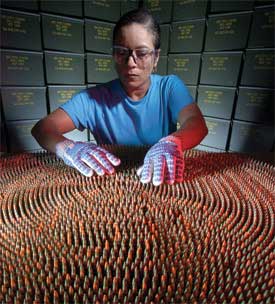 FORT BELVOIR, Va. — The U.S. military's
only plant making small-arms ammunition is running at
near capacity, 4 million rounds a day, and the United
States still is forced to look overseas and to the
recreational industry for ammunition for troops in
Afghanistan and Iraq and those training to deploy there
soon.
FORT BELVOIR, Va. — The U.S. military's
only plant making small-arms ammunition is running at
near capacity, 4 million rounds a day, and the United
States still is forced to look overseas and to the
recreational industry for ammunition for troops in
Afghanistan and Iraq and those training to deploy there
soon.
Gen. Paul Kern, commander of the Army Materiel
Command, said Friday that giving those units priority
ensured they had enough small-arms ammunition. "Everyone
else will have to pay the price" and wait for it, he
said.
The increased demand for ammunition for combat
shooting and intensified training has made deep inroads
in the nation's war reserves of ammunition, Kern said.
The sole plant making small-arms ammunition, the Lake
City Army Ammunition Plant in Independence, Mo., is
running three eight-hour shifts a day, six days a week.
The plant provides 5.56 mm rifle, 7.62 mm and .50
caliber machine gun as well as 9 mm pistol cartridges
for all branches of the military. The plant, run by
Alliant Tech Systems (ATK), provided 800 million rounds
of small arms ammunition to the U.S. Department of
Defense last year.
 Because of the increased demand for ammunition since
the Sept. 11, 2001, attacks and America's wars in
Afghanistan and Iraq, Kern said the Army in late
December let two supplemental contracts to Olin
Winchester of East Alton, Ill., and Israeli Military
Industries for each to produce 70 million rifle rounds
per month starting in June.
Because of the increased demand for ammunition since
the Sept. 11, 2001, attacks and America's wars in
Afghanistan and Iraq, Kern said the Army in late
December let two supplemental contracts to Olin
Winchester of East Alton, Ill., and Israeli Military
Industries for each to produce 70 million rifle rounds
per month starting in June.
The general said it would probably take until 2005 to
get small-arms ammunition production to a level at which
there will be enough to cover all the increased training
needs and begin rebuilding the war reserves.
"We can't just go out and buy our ammunition
commercially," Kern said. "We maintain very tight
quality controls. Our ammo has to work, at 40 below zero
or 140 degrees."
He said the Army has put an additional $225 million
into small-arms ammunition production and additional
armor for Humvees since the 9-11 attacks.
In addition to combat requirements, two other factors
were driving the increased demand for ammunition: increased
live-fire training for combat-service-support units and
the fact that Reserves and National Guard were shooting
as much as the active Army as they trained for deployment
to combat, Kern said.
See followup story on
this issue
Tony's
Note:
If you are a shooter, I would recommend that you buy and
save ammunition right now to make sure that you have what
you want while it is still easily obtained and still very
inexpensive. That may change soon, so be careful.